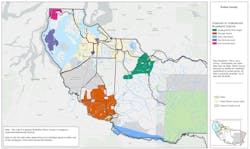Astound Broadband is boosting Pierce County, Washington’s broadband capabilities
Astound Broadband has entered a public-private broadband partnership with Pierce County to bring broadband to several rural and underserved areas of Pierce County for the first time, including Herron Island, Key Peninsula, and the Nisqually region.
Upon completion in 2026, over 3,200 homes will gain access to a fiber-to-the-home (FTTH) network, offering up to 5 Gbps symmetrical speeds.
The partnership is the latest in Pierce County’s initiative to facilitate broadband infrastructure expansion to underserved areas of Pierce County.
Debi Ross, Pierce County Planning & Public Works’ Strategic Business Manager, said the county's work with Astound Broadband came after it evaluated its county's broadband availability or lack thereof.
This is all part of the Boosting Broadband in Pierce County initiative.
“We started in Pierce County in 2019 noticing that there were parts tremendously underserved by broadband,” she said. “Our Pierce County council hired a consultant who did a study that looked at the landscape from a business perspective of what places were covered and what was not.”
She added that broadband is an essential utility for the county recognized as COVID-19 hit. “We recognized broadband’s role during the pandemic,” Ross said. “Also, we noticed that when online school and online work are all really great if you have access to high-speed internet.”
Facilitating broadband expansion
After better understanding its broadband situation, Pierce County pursued American Rescue Plan Act (ARPA) funding.
Ross said the county was allocated nearly $13 million “to incentive the expansion of broadband service; however, we could make it happen in our underserved in unserved areas.”
This project with Astound is a $12.1 million public-private partnership, with Pierce County contributing $7.15 million from federal American Rescue Plan Act (ARPA) funds and Astound covering the remaining $4.95 million.
Pierce County’s partnership with Astound Broadband is the latest initiative to facilitate broadband infrastructure expansion to underserved areas of Pierce County.
The county has two partnerships with internet service providers to expand broadband infrastructure in rural and underserved areas of Pierce County. In addition to Astound, it is working with Comcast to serve North Key Peninsula. Construction began in June 2024, and new customer activations began in September 2024.
This program partners County funding with broadband service providers to build infrastructure that benefits residents and enhances their quality of life and economic opportunities for local businesses.
Pierce County's broadband situation was diverse as a county with a population of under 1 million.
There were a few large cities where broadband was available through a local cable operator or telco, including Comcast, Astound (and the former Wave Broadband).
“Private ISPs provided most broadband service,” Ross said.
As the county was looking at ways to incentivize the allocation of ARPA funding, the county put out an RFP. The goal was to seek a public partner.
“We asked ISPs to partner with us in a cost share mechanism where if they passed homes that were considered underserved or unserved, they could request reimbursement for that construction cost,” Ross said.
Jared Sonne, SVP and general manager of West Region for Astound, recognized it could make a difference in an area that included Herron Island, which lacked broadband services.
“Herron Island had minimal broadband connectivity options,” he said. “The county sent an RFP, and we won the bid.”
Hybrid network configuration
Over the next several months, Astound will build 113 miles of fiber infrastructure throughout Pierce County.
Given the market's unique aspects, the network build will include a mix of aerial and underground fiber construction, as well as a unique microwave process transmitting connectivity from the Key Peninsula ferry terminal to nearby Herron Island. Construction permits are now underway.
The new infrastructure focuses on enhancing connectivity for residents in these underserved areas, supporting their personal and professional needs. Once this project is completed, area businesses will have a new fiber option.
Astound’s network, including the last and middle mile portions, will be 100% fiber. Residential FTTH services will be delivered to each home via XGS-PON.
However, to get to Herron Island, Astound will use millimeter-wave wireless to transmit connectivity from the Key Peninsula ferry terminal to nearby Herron Island.
The provider will use multi-band millimeter radios to communicate wirelessly across the water to the island. Specifically, Astound will use the 80 GHz band to deliver performance and support the bulk of the traffic. It can also use the 23 GHz band to stabilize during inclement weather.
“The millimeter wireless technology delivers carrier-grade performance and reliability across licensed frequencies,” Sonne said.
Millimeter wireless is not new to Astound. The company and its predecessors have used it in Downtown Portland, Oregon, and San Francisco since 2008.
“We go from rooftop to rooftop in a lot of cases to avoid having to dig in the sidewalks and streets of an urban area and bury fiber,” Sonne said. “As long as the network design is such that the microwave technology can handle the traffic, we will use that as often as possible.”
Point-to-point wireless has also come in handy for Astound when providing service in environmentally sensitive areas.
For example, the provider uses millimeter wireless facilities for a proposed project on California's Central Coast.
“There are multiple scenarios where this tool is advantageous,” Sonne said. “For Herron Island, it’s perfect because it’s only 450 homes.”
Rural challenges
Pierce County, Washington, has a unique geography.
Water bisects the county so the Puget Sound, with one half being land and areas that look like islands.
“The islands often have steep slopes and a lot of tree cover,” Ross said. “They have rural neighborhoods where if there were a strong ability to recap the investment, they would have already been served because private companies would have been built out there in those areas.”
The nature of the rural markets has made it challenging to extend services like satellite broadband or wireless 5G.
The areas near the Mt. Ranier side of the county are more rural, making it difficult for ISPs to make a case for serving them effectively.
“These areas have the same challenges, such as the return on investment being too long for ISPs to put in the miles of infrastructure required,” Ross said.
Besides its county's rural nature, another key difference is the presence of large technology industries in the area.
“Being in the shadow of big companies based in Seattle, having one county away that’s still unserved by high-speed Internet feels like we could be doing better,” Ross said. “That’s one of the pushes to ensure our county can participate in the digital economy like other counties nearby.”
Another project was set up within Pierce County to serve the town of Roy, Washington, in the area.
Officially incorporated on January 16, 1908, Roy is a rural city outside Tacoma and primarily features ranch-style homes and farms.
“In the town of Roy, there are a lot of rural homes that are difficult and expensive to get to, which is why they don’t have decent broadband options,” Sonne said. “This is why a significant portion of the project will be built using grant money, and Astound will significantly contribute to the project's cost.”
Upon completion, Astound can deliver symmetrical 5 Gbps residential internet service to about 3,200 homes. Today, the local telco delivers limited DSL-based service with a maximum speed of 20 Mbps.
“This project will bring these areas up to what should be expected and what is commonly expected in suburban areas,” Sonne said.
Eying BEAD
Another critical question in the future is how Pierce County and others will be able to benefit from the Broadband Equity Access and Deployment (BEAD) program.
Washington State is slated to get nearly $1.2 billion in BEAD funding. The state’s budget writers appropriated $1.5 million in one-time state funding to provide technical assistance to BEAD grantees.
Legislators also indicated their intention to make matching funds available in the 2025-2027 biennium.
Today, the Wash State Broadband office is managing the BEAD process.
Like the agreement with Astound, Pierce County will seek opportunities to leverage BEAD funding as it becomes available by working with local ISPs.
“The state broadband office is preparing their first Notice of Funding Opportunity (NOFO), which we’re anticipating will be coming out at the end of the year,” Ross said. “We’re not sure what the full grant requirements will be, but we hope to pursue them with private partners.”
For related articles, visit the Business Topic Center.
For more information on high-speed transmission systems and suppliers, visit the Lightwave Buyer’s Guide.
To stay abreast of fiber network deployments, subscribe to Lightwave’s Service Providers and Datacom/Data Center newsletters.
About the Author
Sean Buckley
Sean is responsible for establishing and executing the editorial strategy of Lightwave across its website, email newsletters, events, and other information products.




